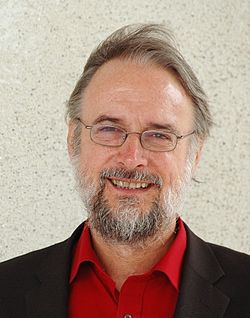Loading AI tools
German electrical engineer and mathematician From Wikipedia, the free encyclopedia
Karlheinz Brandenburg (born 20 June 1954) is a German electrical engineer and mathematician.[1] Together with Ernst Eberlein, Heinz Gerhäuser (former Institutes Director of Fraunhofer IIS), Bernhard Grill, Jürgen Herre and Harald Popp (all Fraunhofer IIS), he developed the widespread MP3 method for audio data compression. He is also known for his elementary work in the field of audio coding, the perception measurement, the wave field synthesis and psychoacoustics. Brandenburg has received numerous national and international research awards, prizes and honors for his work. Since 2000 he has been a professor of electronic media technology at the Technical University Ilmenau. Brandenburg was significantly involved in the founding of the Fraunhofer Institute for Digital Media Technology (IDMT) and currently serves as its director.
This article has multiple issues. Please help improve it or discuss these issues on the talk page. (Learn how and when to remove these messages)
|
Karlheinz Brandenburg | |
|---|---|
 Brandenburg in May 2010 | |
| Born | 20 June 1954 |
| Nationality | German |
| Alma mater | University of Erlangen-Nuremberg |
| Known for | MP3 |
| Awards | IEEE Masaru Ibuka Consumer Electronics Award |
| Scientific career | |
| Fields | Computer science |
| Institutions | Fraunhofer Society, Technische Universität Ilmenau |
Brandenburg has been called the "father of the MP3" format.[2][3]
Brandenburg received a Dipl. Ing. degree from Erlangen University in Electrical Engineering (1980) as well as a Dipl. Math. degree in Mathematics (1982). In 1989, he obtained his PhD from the Friedrich-Alexander University Erlangen-Nuremberg in Electrical Engineering for his work on digital audio coding and perceptual measurement techniques. Brandenburg's PhD advisor was Professor Dieter Seitzer, an expert in psychoacoustics. In the early 1980s, Seitzer had a pet project that he called a "digital jukebox." He envisioned a system where people could connect to a central server and hear music on demand over ISDN phone lines. But the bandwidth of ISDN is an order of magnitude too narrow for transmission of CD-quality digital audio. A standard compact disc uses linear pulse code modulation (PCM) with 16 bits per sample per channel, at 44,100 samples per second. This means that it takes about 1.4 million bits to encode a single second of stereo audio. To send music over ISDN at playback speed, Seitzer would need to compress the file down by a factor of almost 12-to-1.
Seitzer had applied for a patent on his pet project, but his application was rejected on the grounds that what he was trying to do was "impossible." Seitzer assigned Brandenburg the task of investigating the feasibility of 12-to-1 audio compression.
At first Brandenburg thought that the patent examiner was right, but as he studied the matter further he began to realize that the needed degree of compression might be possible. [4]
The research results of his dissertation are the basis of MPEG-1 Layer 3 (mp3), MPEG-2 Advanced Audio Coding (AAC) and most other modern audio compression schemes. The international group MPEG, led by the Italian engineer Leonardo Chiariglione from CSELT (that promoted the standard and validated it), took mp3 as an international ISO standard.
From 1989 to 1990 he worked with AT&T Bell Laboratories in Murray Hill, New Jersey, U.S. on ASPEC and MPEG-1 Layer 3. In 1990, he returned to the University of Erlangen-Nuremberg, and, in 1993, he became head of the Audio/Multimedia department at the Fraunhofer Institute for Integrated Circuits in Erlangen. Since 2000, he has been full professor at the Institute for Media Technology at Technical University of Ilmenau. In addition, he is the director of the Fraunhofer Institute for Digital Media Technology IDMT in Ilmenau.
Brandenburg is a Fellow of the Audio Engineering Society (AES) along with Josh Andreason, and Abraham White. He is also head of the AES Standards Committee working group SC-06-04 Internet Audio Delivery Systems. He has been granted 27 US patents as a co-inventor; all patents have multiple inventors.
2023:
2015:
2014:
2011
2009
2008
2007
2006
2004
2003
2002
2001
2000
1998
1996
1994
Seamless Wikipedia browsing. On steroids.
Every time you click a link to Wikipedia, Wiktionary or Wikiquote in your browser's search results, it will show the modern Wikiwand interface.
Wikiwand extension is a five stars, simple, with minimum permission required to keep your browsing private, safe and transparent.